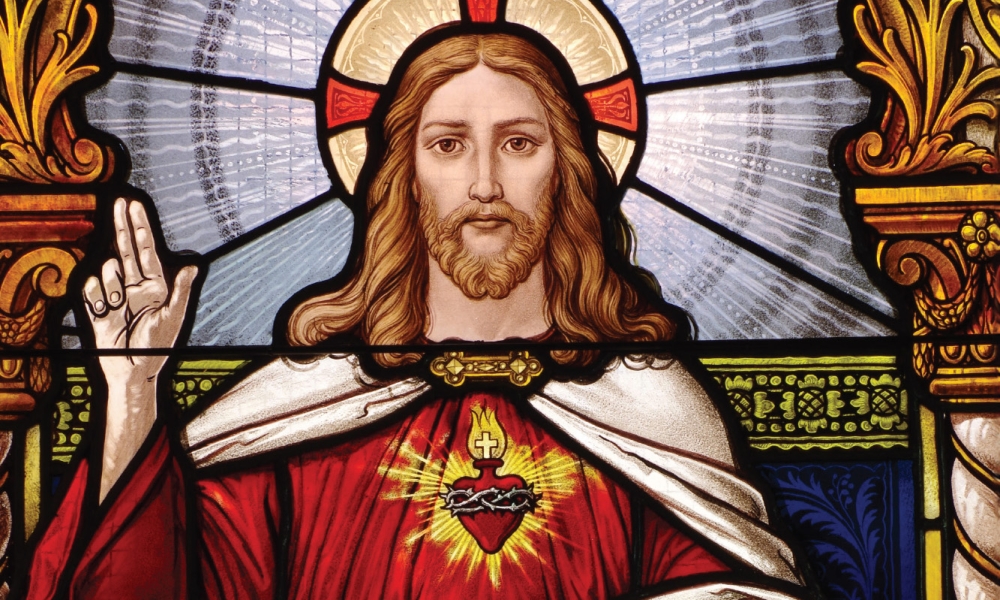
A look at the Sacred Heart
From a distance, it can look as though the statue of Jesus shows him wearing a medallion — you know, one like those worn by university chancellors in full graduation day garb or by those who have just received a papal honor at solemn vespers. But a closer approach reveals the heart — the image of the Sacred Heart, encircled with thorns and crowned by flames.
From a distance, it can look as though the statue of Jesus shows him wearing a medallion — you know, one like those worn by university chancellors in full graduation day garb or by those who have just received a papal honor at solemn vespers. But a closer approach reveals the heart — the image of the Sacred Heart, encircled with thorns and crowned by flames.
The image and devotion to the Sacred Heart of Jesus dates back to the late 17th century when St. Margaret Mary Alacoque confided her visions to a confessor. She indicated that Jesus was asking for a rekindling of devotion and reparation for sins against the holy Eucharist. He also was offering assurance of the immense mercy of God.
This was especially important for at least two reasons. One is that it provided an antidote to Jansenism, which preached a vengeful God who was ill disposed to bestow forgiveness — not quite the “plentiful redemption” preached a century later by St. Alphonsus Liguori (based on Psalm 130). A second reason, articulated by one of my professors of theology while in graduate school, was simply that Catholics were in need of not only intellectual formation and moral preaching but also an affective attraction to the God who is indeed love.
Devotion to Jesus, manifested through the Sacred Heart, grew as the faithful learned of it; artists depicted Jesus with a burning heart, and popes promoted it by instituting a feast celebrated eight days after Corpus Christi, the third Friday after Pentecost. This year the Solemnity of the Most Sacred Heart of Jesus takes place on June 7. Along with the formal liturgical observance, the devotion has included the practice of making holy hours on the vigil and then receiving communion on nine consecutive First Fridays.
Many have participated in a special consecration to the Sacred Heart and have enthroned an image in their homes. One of the sisters in my religious community spent several decades strategizing ways and succeeding in smuggling Sacred Heart devotionals and materials into Slovakia while the country was under Communist rule and religious oppression.
In our diocese, we have churches named Sacred Heart in Charleston, Abbeville, Blackville and Gaffney. As we take another look at the devotion and the solemnity, it seems timely to reflect on what the title or name Sacred Heart implies.
The truth is that Jesus is madly in love with us. The statues and paintings depicting the Sacred Heart typically show either Jesus’ right hand raised in blessing or extended out to us in a hearty welcome. The litany of the Sacred Heart speaks of the heart “aflame with love for us,” as the “source of justice and love,” “wellspring of all virtue,” “desire of the eternal hills,” a heart that is “patient and full of mercy” and “broken for our sins.” Jesus’ heart is gentle, humble, aching to help us and willing to give all to bring us home.
That is really the message of the image and the devotion. It isn’t about a bodily organ, slightly misplaced and artfully designed. It’s about passionate love that emanates from the heart of the living God. It is about the source of all good and hope — that there are welcoming arms awaiting all of us. With that, of course, comes our inevitable Christian conclusion: we are charged to go and do likewise — love widely, love warmly, give what we receive and be on fire.
Sister Pamela Smith, SSCM, Ph.D., is the diocesan director of Ecumenical and Interreligious Affairs. Email her at psmith@charlestondiocese.org.
